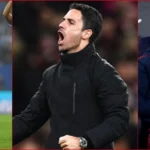Arsenal Football Club has always been synonymous with a proud legacy, a distinct style of play, and a passionate fanbase. Over the past few seasons, the Gunners have been on a rollercoaster ride of emotions. From the highs of unexpected victories to the frustration of inconsistency, the journey under Mikel Arteta has been one of steady progression and growing ambition. Now, as Arsenal fights to return to the pinnacle of English football, it’s worth analyzing the team’s recent form, understanding what is clicking on the pitch, and identifying the areas that still need improvement.
Arsenal Recent Form: A Glimpse of Consistency?
In the 2023-24 season, Arsenal has begun to display a sense of stability that has been lacking in recent campaigns. The Gunners finished second in the Premier League the previous year, falling just short of clinching the title, but their performances demonstrated that they are a team capable of competing with the very best. Heading into the new season, expectations were high. The key question was whether Arsenal could sustain their top-four form and challenge for silverware across multiple competitions.
Early results have been encouraging, with Arsenal sitting near the top of the table, pushing for Champions League success, and showing consistency in their performances. But while the team’s form has been positive, it hasn’t been without its flaws. Let’s break down the current state of the team by analyzing what’s working well and where improvements can be made.
What’s Working for Arsenal?
1. Solid Defensive Structure
One of the standout aspects of Arsenal’s recent form has been their defensive organization. Mikel Arteta, a disciple of Pep Guardiola, has placed a strong emphasis on building from the back, and it’s paying off. Arsenal’s backline has looked more cohesive than in previous years, thanks to the partnership between key defenders such as William Saliba, Gabriel Magalhães, and Ben White.
The introduction of Oleksandr Zinchenko has also added a new dynamic to Arsenal’s play, allowing for more fluid transitions from defense to attack. Zinchenko’s ability to tuck into midfield and act as an inverted full-back creates numerical superiority in the middle of the pitch, giving Arsenal more control in possession.
Additionally, goalkeeper Aaron Ramsdale has been exceptional between the posts. Ramsdale’s shot-stopping ability, combined with his comfort on the ball, has given Arsenal confidence in building attacks from deep. His presence provides a solid foundation, allowing Arsenal to play a high line without too many concerns about being caught on the counter.
2. Midfield Dominance: The Partey-Rice-Odegaard Trio
Arsenal’s midfield has been one of the most improved areas, and it is no coincidence that their recent form has been driven by the dominance of this department. The addition of Declan Rice from West Ham has been a game-changer. Rice brings not only defensive solidity but also leadership and composure to the midfield. His ability to break up play and shield the defense gives Arsenal more balance, something they had been lacking in previous seasons.
Meanwhile, Thomas Partey, when fit, remains a key cog in Arteta’s system. Partey’s energy, physicality, and ability to win the ball back have helped Arsenal control the midfield battle in most matches. Playing in tandem with Rice allows Partey to roam forward and contribute to attacks more freely.
At the heart of Arsenal’s creative engine is captain Martin Ødegaard. The Norwegian playmaker has been in superb form, pulling the strings in midfield with his vision and technique. Ødegaard’s ability to find pockets of space and deliver precise through balls has opened up numerous attacking opportunities for the Gunners. His leadership on the pitch has also grown, and he is instrumental in maintaining the team’s high press and fluid passing game.
3. Dynamic Attack: Saka, Martinelli, and Jesus
One of Arsenal’s greatest strengths has been their dynamic front three, featuring Bukayo Saka, Gabriel Martinelli, and Gabriel Jesus. Saka has established himself as one of the best young wingers in Europe. His ability to beat defenders one-on-one, deliver pinpoint crosses, and cut inside to shoot makes him a constant threat. Saka’s chemistry with Ben White on the right flank has been one of Arsenal’s most effective attacking outlets, providing width and pace.
On the opposite side, Martinelli’s pace and directness have caused problems for defenders across the league. The Brazilian winger’s ability to stretch the opposition and create space for his teammates is invaluable to Arsenal’s attacking fluidity. Martinelli has also developed a knack for scoring important goals, making him a crucial component of Arteta’s game plan.
Gabriel Jesus, while not a traditional No. 9, has adapted well to Arsenal’s style of play. His movement, ability to drop deep, and link-up play with Saka and Martinelli have allowed Arsenal’s attack to be more unpredictable. Although Jesus isn’t as prolific as some other strikers in the league, his work rate and off-the-ball contributions are invaluable to the team’s pressing system.
4. High Press and Possession Play
Arteta has instilled a high-pressing style of play at Arsenal, and this has become one of their trademarks. The Gunners are one of the most effective teams in the league at winning the ball back in advanced areas, thanks to their coordinated pressing. This allows them to create chances in transition and exploit the opposition’s defensive lapses.
In possession, Arsenal’s buildup play has become more sophisticated. The introduction of Zinchenko’s inverted full-back role, the technical proficiency of Ødegaard, and the presence of a holding midfielder like Rice have allowed Arsenal to dominate possession against most teams. This ability to control the tempo of the game has been a key factor in their improved form.
What Needs Improvement?
While Arsenal’s recent form has been impressive, there are still areas that need improvement if they are to truly challenge for the Premier League title and make a deep run in the Champions League.
1. Consistency in Finishing
Despite their dynamic attack, one area where Arsenal can improve is their finishing. The Gunners often create numerous chances but fail to convert them into goals. This has been especially evident in matches where they dominate possession but struggle to put the game to bed.
Gabriel Jesus, while integral to Arsenal’s attacking play, has at times been wasteful in front of goal. The Brazilian forward is not known for being a prolific goal-scorer, and this lack of a true No. 9 has occasionally hurt Arsenal in tight games. The team needs a more clinical presence in the box to capitalize on the chances they create.
Eddie Nketiah, Jesus’ backup, has shown glimpses of promise but is still inconsistent at the highest level. Arsenal may need to consider bolstering their attacking options in future transfer windows to ensure they have a reliable goal-scorer who can make the difference in big games.
2. Depth in Defense
While Arsenal’s first-choice defenders have been solid, there are concerns about the depth in defense. Injuries to key players such as William Saliba or Gabriel Magalhães could expose Arsenal’s lack of experienced cover at the back. Jakub Kiwior and Rob Holding have provided backup in previous seasons, but neither have shown the consistency required to step up in crucial matches.
In addition, the full-back positions could use more depth. While Kieran Tierney and Takehiro Tomiyasu are capable players, both have struggled with injuries in recent years. Arsenal may need to look for reinforcements in the transfer market to ensure they have adequate cover in case of injuries.
3. Tactical Flexibility
Although Arsenal’s high-pressing, possession-based style has been effective, there are times when the team lacks tactical flexibility. In matches against well-organized defenses or teams that sit deep, Arsenal has struggled to break down the opposition. The team could benefit from having a “Plan B” in such scenarios—whether it’s adopting a more direct style of play or bringing in a more traditional striker to offer a different attacking option.
Arteta’s reliance on the same system can make Arsenal predictable at times, and adding more variety to their tactical approach could be key to unlocking stubborn defenses. Developing alternative strategies for games where the high press and intricate passing don’t work will be crucial as the team aims to compete on multiple fronts.
The Path Forward for Arsenal
Arsenal’s recent form has been a reflection of a team that is growing in confidence and maturity. Under Mikel Arteta, the Gunners have developed a strong identity, blending defensive solidity with creative attacking play. The team’s core of young talents, combined with key signings like Declan Rice and the emergence of Bukayo Saka as a world-class talent, has given fans optimism for the future.
However, to take the next step and truly challenge for major trophies, Arsenal will need to address their finishing issues, strengthen their squad depth, and add tactical flexibility to their game plan. With the right tweaks and continued development, the Gunners have the potential to return to the summit of English football.
As the season progresses, all eyes will be on Arteta and his squad to see if they can maintain their form and continue to improve in the areas where they’ve struggled. The ambition is clear: Arsenal wants to be back on top. Whether they can achieve that will depend on their ability to learn from both their successes and their shortcomings.


